No Lions, No Tigers-- but Polar Bears, Oh My!
 •
by
•
by bombonato

Who have died so we may live free.
Dateline: Monday May 30, 2011 (Day 1287)
Location: Selfridge ANGB, Michigan
Reporter: Major George Armstrong "Old Man" Custer

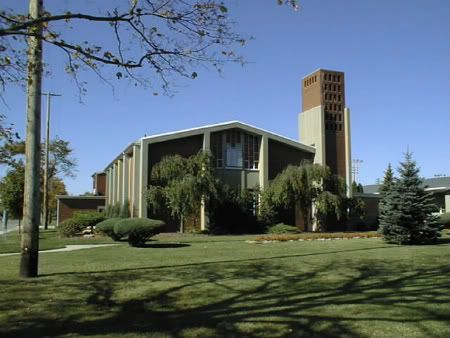
The Chapel at Selfridge ANGB.
Memorial Day morning at Selfridge Air National Guard Base in Mt. Clemens MI, is quiet. Special services were held at the base Chapel, and 127th Mission Support Group Commander Lieutenant Colonel Mac A. Crawford led a prayer at breakfast.
While many base personnel gave up their day off to prepare aircraft for their weekend guests' transport home, a day trip was arranged for the families.

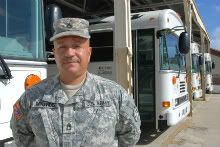
FFC Kessukas and SSG ManOfMagic help prepare box lunches, and
Ranger Sgt Hadrian X wrangled several buses for the families' day trip
Editor's Note:
My friend Tom's grandfather was a member of the fighting unit featured in today's article.
As I am just learning about the Polar Bears, myself, I feel the best service I can do for these heroes, and readers of the Army Times, is to lift text from various online sources and provide links to the materials so you might read and learn more on your own.

The Polar Bear Monument is located within White Chapel Cemetery, Troy, MI.
The 81st annual Memorial Day service was held today at the site of the Polar Bear Monument and the graves of the many soldiers who lost their lives in North Russia.
A History Lesson, in excerpts:
Prior to the collapse of Russia in 1917, vast quantities of military supplies had been assembled in the northern part of that country at the ports of Archangel and Murmansk, the latter being an open port north of the Arctic Circle.
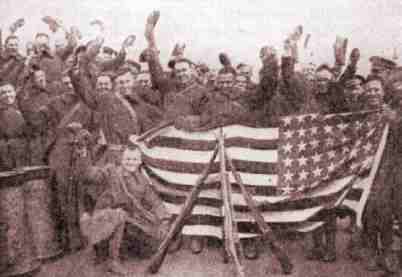
The 339th Infantry Leaves for Russia
The Polar Bear Expedition was sent to Russia by the U.S. President Woodrow Wilson in response to requests from the governments of Great Britain and France to join the Allied Intervention in North Russia (also known as the North Russia Campaign).
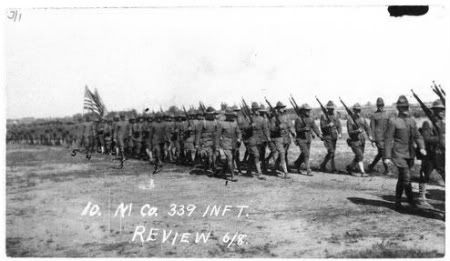
On July 14, 1918, the U.S. Army's 85th Division left their training camp at Camp Custer, Michigan for the Western Front in France. Three days later, President Wilson agreed to a limited participation by American troops in the Allied Intervention with the stipulation that they would only be used for guarding the stockpiled war material. When U.S. Army General John J. Pershing received the directive from President Wilson, he changed the orders for the 339th Infantry Regiment, along with the First Battalion of the 310th Engineers plus a few other ancillary units from the 85th Division. Instead of heading for France, these units were trained and re-outfitted in England with Russian guns and then sent to North Russia, where they arrived in Arkhangelsk on September 4, 1918 and placed under British command.
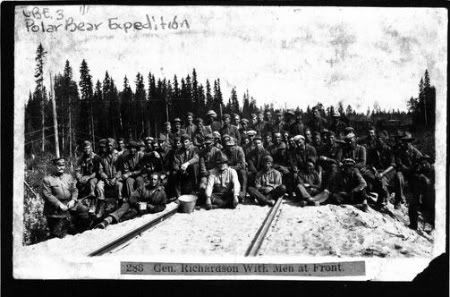
When American troops reached their destination in early September, they joined an international force commanded by the British that had been sent to northern Russia for purposes never made clear. Whatever the reasons for the intervention, however, the force was fighting the Bolsheviks who had taken power in Petrograd and Moscow the previous winter.

The strategy of the expedition's commanders was to advance south and east to join Russian and foreign anti-Bolshevik armies hundreds or even thousands of miles away. Fighting during the winter of 1918-1919 was concentrated in six areas scattered across Archangel Province in a semicircle south of the city.

Operating under British command, the American soldiers soon participated in the fighting, their first casualties occurring on September 16 in the general area to the south of Obozerskaya.
During their service in Russia the American troops conducted many small operations under arduous conditions, the normal hardships of warfare being intensified by the deep snow, intense cold, and the darkness of winter in the Arctic Zone. Isolated detachments protected the long lines of communication, which were in constant danger of being cut by the enemy.

Two companies of the U. S. Army Transportation Corps arrived in Murmansk, 400 miles northwest of Archangel, in April 1919. Their duty was to maintain and operate the Murmansk railroad, running parallel to the Archangel-Vologda railroad but 200 miles farther west.
The small American contingent was soon split with Allied troops and Russian volunteers guarded the vital points on the railroads and rivers which were the main avenues of approach to the coast.
As the guns of the Western Front fell silent, the Polar Bears were called upon to fight for their lives.
A winter of fighting Bolsheviks and wondering why they were still in combat when the war with Germany had ended led to severe morale problems among the American troops, including an alleged mutiny in March 1919 by members of one company in Archangel, and the presentation of an antiwar petition by members of another company in the same month. The troops were ready for the new American commander who arrived at Archangel in April 1919 with orders to withdraw. As soon as navigation opened in June, the American forces left northern Russia.
In the opinion of the senior American officer, the expedition was not particularly well managed and his troops were subjected to needless hardships. More than 400 casualties were suffered by this small American force, most of them occurring after the lightning had ceased on the Western Front. In spite of this, however, and the trying nature of their service, the American units performed their duties with great fortitude and bravery.
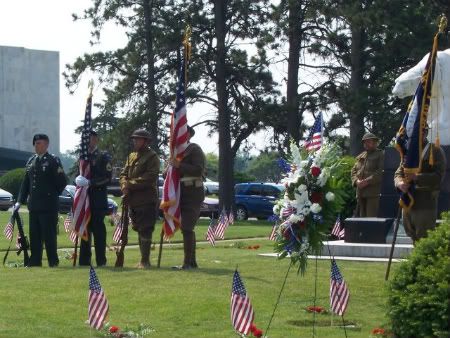
The "Detroit's Own" Polar Bear Memorial Association is dedicated to honoring and maintaining the memory of the 339th Infantry Regiment, the 1st Battalion of the 310th Engineers, the 337th Ambulance Co. and the 337th Field Hospital of the U.S. Army's 85th Division.
Resources:
Wikipedia: Polar Bear Expedition
University of Michigan: Polar Bear Expedition Digital Collections and Polar Bear History.
Doughboy History: The Story of the American Expeditionary Forces; American Polar Bears
"Detroit's Own" Polar Bear Memorial Association
Homeward deployment
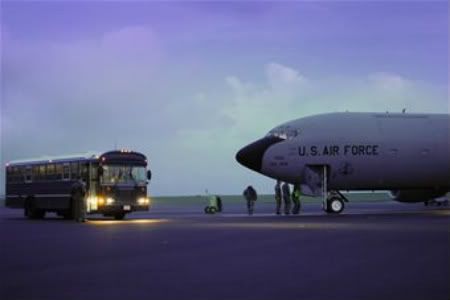
The soldiers and families of the eRep USArmy wish to thank our gracious hosts, the soldiers and extended families of Selfridge Air National Guard Base. This Memorial Day weekend will be long remembered and appreciated by all.
o7, Selfridge! Hoo-ah!
Haven't you heard? There's a War on!
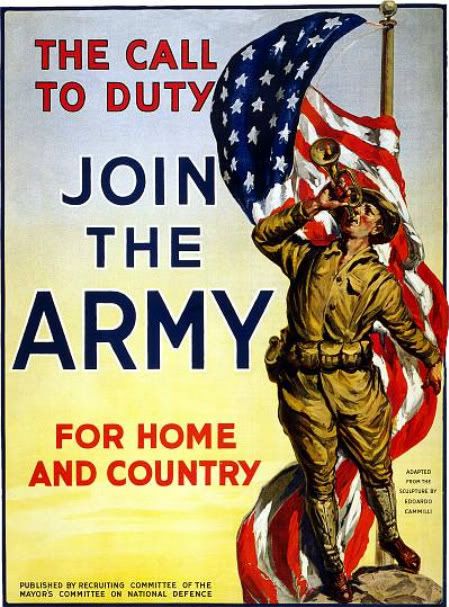
Army Application: Link


Major George Armstrong Custer
Army Public Affairs Senior Officer
 Recommended Reading:
Recommended Reading::::
Sh-h-h-h-h!
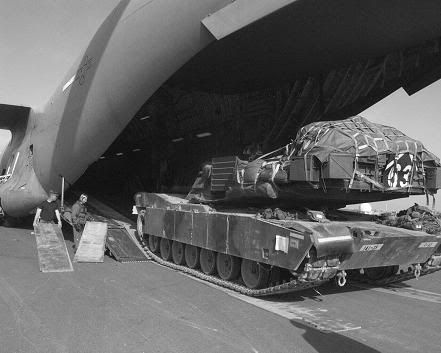
USMarine Helkz has **somehow** managed to secure a C130 Hercules loaded with Abrams M1A1 tanks, and has instructed me to distribute them to highly motivated patriots.
The following Army Times readers have posted Comments to all three of the previous articles, and are hereby awarded three Q5 tanks each:
USArmy 1st Division CO Lt. Col. RedbirdUSA
USArmy Intel Senior Colonel TheHarvester
Receiving one Q5 tank will be those Army Times readers who have Commented to two of the past three articles:
SVV, Ethan Deluca, Libby, TeddyRoosevelt, Glove, and darksrevan
The first ten readers to post, in the Comments of this article,
an "o7" salute AND a link to the home page of a RL US Army fighting unit or Division
will receive one Q3 tank, complements of retired eRep player, USAirborne officer and Ultramarine fighter, TheSpartan.
EDIT: The first twenty will be getting Q5 tanks!
It pays to read the Army Times!
:::


Comments
The soldiers and families of the eRep USArmy wish to thank our gracious hosts, the soldiers and extended families of Selfridge Air National Guard Base. This Memorial Day weekend will be long remembered and appreciated by all.
o7, Selfridge! Hoo-ah!
o7
http://www.drum.army.mil/Pages/index.aspx
"Warriors"!
O7
http://www.170infantry.army.mil/
170th Infantry Brigade ... Motto: "Strength Honor Discipline"
o7!
my eRep USArmy unit is the 5th Division, so I looked them up.
The 5th ID became the first Allied unit to cross the Rhine River on the night of 22 March 1945.
The division was inactivated for the final time on 24 November 1992 as part of the post-Cold War rundown of US forces.
http://en.wikipedia.org/wiki/5th_Infantry_Division_(United_States)
Take a moment to remember our fallen hero's.
o>
https://www.mi.ngb.army.mil/mission/
O7
http://www.1id.army.mil/
Since the spring of 1998, Fort Hamilton Military Community has been home to the North Atlantic Division, U.S. Army Corps of Engineers. The post is located in the Bay Ridge section of Brooklyn, N.Y., at the base of the world-famous Verrazano Narrows Bridge.
http://www.nad.usace.army.mil/fh.htm
I'll take that "o>" as a salute, rainy, since I know your heart's in the right place.
but that (https) link yields a "security alert" page! here's one that works:
http://www.mi.ngb.army.mil/mission/
Michigan National Guard... YEAH, baby!
Thanks for fixing that, Custer. Google fail 9_9
Camp Grayling ARNG represent.
o7
I wanted a tank!
07
07
http://www.2id.korea.army.mil/ A tank for a poor TC soldier stuck in N. Korea? 😃
Since Libby took my most recent Army division, I thought I'd take my first one.
The 25th infantry division earned their nickname "electric strawberry" from their strawberry-looking patch with a lightning bolt on it. They're based out of Hawaii and earned another nickname "Tropic Lightning" from their fast response times.
http://en.wikipedia.org/wiki/25th_Infantry_Division_(United_States)
o7
EDIT: The first twenty will be getting Q5 tanks!
Shout this mutha around, let's rock this article up the charts and give away some tanks!
Today's Army Times:
http://www.erepublik.com/en/article/no-lions-no-tigers-but-polar-bears-oh-my--1786796/1/20
It PAYS to read the Army Times! (it really does)
voted, TC
o7
o7
o7
07
Only one in Illinois, but website is down 🙁
http://www.ria.army.mil/
o7
great article, very interesting
Voted as always!
o7
o7
o7
My Alma Mater when I was in Germany now they proudly train the best @ NTC.
11th Armored Calvary Black Horse
O7
http://www.170infantry.army.mil/
170th Infantry Brigade ... Motto: "Strength Honor Discipline"
enjoyed your article, thank you
Forgot the link to 11th ACR
http://www.irwin.army.mil/UnitsandTenants/11acr/Pages/default.aspx
Camp Grant, retired Army base in Rockford, IL
http://en.wikipedia.org/wiki/Camp_Grant_(Illinois)
Haliman's Rock Island (Illinois) Arsenal website is, indeed, down. but here's a pretty professional and seemingly authoritative site:
http://themilitarystandard.com/army_base/il/ria.php
hey, you guys are good!
o7
yay michigan
http://unitpages.military.com/unitpages/unit.do?id=723670
North Russia Campaign! Awesome, I've been meaning to read up on that. I never knew that American forces were lead by the British in that campaign. Thanks for the history lesson.
07
http://www.oak-hill.navy.mil/default.htm
USN hooyah!
o7
It's possible to honor soldiers without uncritically buying into the politics of perpetual war.
The invasion of Soviet Russia by the imperialist countries was illegal, fruitless and a failure. It backfired -- as so many of these types of adventures do -- by creating martyrs and a sense of paranoia that the Stalinists mined for many decades. That is was organized by the British Empire tells us something.
o7
o7, I suppose I should read instructions, http://www.quartermaster.army.mil/
good article voted
o7
www.or.ng.mil/sites/RI/army/history
Yarg!
o7
These guys fly out of Oceana NAS, and if you're out on Virginia Beach sometimes it feels like they going to land right next to you.
http://www.tecom.usmc.mil/schldtch/matsg33/
o7
Voted
( 😁 ) https://www.youtube.com/redirect?q=%6e%61%6b%65%64%2d%67%69%72%6c%73%2e%6f%6e%6c%69%6e%65%2f%6b%6b%2f%78%6b%44%57%43%39%3f%73%6f%75%72%63%65%3d%65%72%65%70%75%62%6c%69%6b%26%61%64%5f%63%61%6d%70%61%69%67%6e%5f%69%64%3d1786796